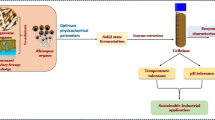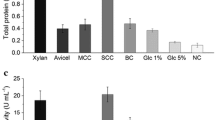Abstract
Parthenium hysterophorus biomass can be used as a non-conventional renewable feedstock for the production of bioethanol. Therefore, the present work was designed to hydrolyze P. hysterophorus biomass using cellulase enzyme produced from an actinomycete, i.e., Streptomyces sp. NAA2 using P. hysterophorus biomass as a substrate. The isolate NAA2 was identified by molecular characterization of 16SrDNA. The enzyme production by strain NAA2 was enhanced by optimization studies conducted under submerged fermentation conditions using P. hysterophorus as a substrate. The crude enzyme produced under optimized conditions was used to hydrolyze alkali-acid pretreated P. hysterophorus biomass. The highest CMCase production was achieved in 4–5 days when steam-pretreated P. hysterophorus biomass was used at 1% (w/v) concentration, using 2 discs (1 disc = 5 × 107 spores/ml) of inoculum, an initial pH 6.5, temperature at 40 °C, an agitation speed of 120–150 rpm, and by supplementing fermentation medium with 1.5% (w/v) carboxymethyl cellulose (CMC) as additional carbon source. Under optimized conditions, the actinomycete strain NAA2 showed production of 0.967 ± 0.016 U/ml CMCase, 0.116 ± 0.08 FPU/ml FPase, and 0.22 ± 0.012 U/ml β-glucosidase enzymes. On utilizing the cellulase enzyme for biomass hydrolysis, maximum 18.2% saccharification yield (of cellulose 0.202 g/g) was achieved in 96 h when enzyme and substrate levels were 30 FPU/100 ml and 2% (w/v) respectively. Parthenium hysterophorus biomass can be hydrolyzed enzymatically yielding considerable amounts of total reducing sugars. It can, therefore, be used as a feedstock for the production of bioethanol. Also, it has the potential to act as a substrate for the production of cellulases. Furthermore, the improved cellulolytic potential of Streptomyces sp. NAA2 can be exploited in various industrial applications.







Similar content being viewed by others
References
Adiguzel AO, Tuncer M (2017) Production and characterization of partially purified thermostable endoxylanase and endoglucanase from novel Actinomudura geliboluensis and the biotechnological applications in the sachharification of lignocellulosic biomass. BioResources 12:2528–2547
Ahmed I, Zia MA, Iqbal HMN (2010) Bioprocessing of proximally analyzed wheat straw for enhanced cellulase production through process optimization with Trichoderma viride under SSF. World Acad Sci Eng Technol 37:1208–1214
Amore A, Giacobbe S, Faraco V (2013) Regulation of cellulase and hemicellulase gene expression in fungi. Curr Genomics 14:230–249
Behera BC, Mishra RR, Singh SK, Dutta SK, Thatoi H (2016) Cellulase from Bacillus licheniformis and Brucella sp. isolated from mangrove soils of Mahanadi river delta, Odisha, India. Biocatal Biotransformation 34:44–53
Bettache A, Messis A, Boufassa L, Boucherba N, Belhamiche N, Kecha M, Copinet E, Duchiron F, Benallaoua S (2014) Production of endoglucanase by a novel strain Streptomyces sp. TKJ2 and its optimization under submerged fermentation. Biotechnol (Rajkot) 10:29–36
Brijwani K, Vadlani PV (2011) Cellulolytic enzymes production via solid-state fermentation: effect of pretreatment methods on physicochemical characteristics of substrate. Enzym Res 2011
Budihal SR, Agsar D (2015) Exploration of agrowastes for the production of cellulase by Streptomyces DSK29 under submerged and solid state systems. Int J Curr Microbiol App Sci 4:681–689
Chellapandi P, Jani HM (2008) Production of endoglucanase by the native strains of Streptomyces isolates in submerged fermentation. Braz J Microbiol 39:122–127
Choudhary J, Saritha M, Nain L, Arora A (2014) Enhanced Saccharification of steam-pretreated rice straw by commercial cellulases supplemented with xylanase. J Bioproces Biotech 4:1–6
Da Vinha FNM, Gravina-Oliveira MP, Franco MN, Macrae A, da Silva Bon EP, Nascimento RP, Coelho RRR (2011) Cellulase production by Streptomyces viridobrunneus SCPE-09 using lignocellulosic biomass as inducer substrate. Appl Biochem Biotechnol 164:256–267
Dashtban M, Buchkowski R, Qin W (2011) Effect of different crabon sources on cellulase production by Hypocrea jecorina (Trichoderma reesei) strains. Int J Biochem Mol Biol 2:274–286
Deka D, Das SP, Sahoo N, Das D, Jawed M, Goyal D, Goyal A (2013) Enhanced cellulase production from Bacillus subtilis by optimizing physical parameters for bioethanol production. ISRN Biotechnol:2013
El-Naggar NEA, Abdelwahed NAM (2012) Optimization of process parameters for the production of alkali-tolerant carboxymethyl cellulase by newly isolated Streptomyces sp. strain NEAE-D. Afr J Biotechnol 11:1185–1196
El-sersy NA, Abd-elnaby H, Abou-elela GM, Ibrahim HA, El-toukhy NM (2010) Optimization, economization and characterization of cellulase produced by marine Streptomyces ruber. Afr J Biotechnol 9:6355–6364
Escobar JC, Lora ES, Venturini OJ, Yáñez EE, Castillo EF, Almazan O (2009) Biofuels: environment, technology and food security. Renew Sust Energ Rev 13:1275–1287
Fatokun EN, Nwodo UU, Okoh AI (2016) Classical optimization of cellulase and xylanase production by a marine Streptomyces species. Appl Sci 6:286
Gama R, Van Dyk JS, Burton MH, Pletschke BI (2017) Using an artificial neural network to predict the optimal conditions for enzymatic hydrolysis of apple pomace. 3 Biotech 7:1–10
Ghose TK (1987) Measurement of cellulase activities. Pure Appl Chem 59:257–268
Gnanavel I (2013) Parthenium hyterophorus L.: a major threat to natural and agro eco-systems in India. Sci Int 1:124–131
Haritha R, Sivakumar K, Swathi A, Jagan Mohan YSYV, Ramana T (2012) Chracaterization of marine Streptomyces carpaticus and optimization of conditions for production of extracellular protease. Microbiol J 2:23–35
Hsu CL, Chang KS, Lai MZ, Chang TC, Chang YH, Jang HD (2011) Pretreatment and hydrolysis of cellulosic agricultural wastes with a cellulase-producing Sterptomyces for bioethnaol production. Biomass Bioenergy 35:1878–1884
Imran M, Anwar Z, Irshad M, Asad MJ, Ashfaq H (2016) Cellulase production from species of fungi and bacteria from agricultural wastes and its utilization in industry: a review. Adv Enzyme Res 4:44–55
Jaradat Z, Dawagreh A, Ababneh Q, Saadoun I (2008) Influence of culture conditions on cellulase production by Streptomyces Sp. (strain J2). Jordan J Biol Sci 1:141–146
Karim A, Nawaz MA, Aman A, Qader SAU (2015) Hyper production of cellulose degrading endo (1,4) β-D-glucanase from Bacillus licheniformis KIBGE-IB2. J Radiat Res Appl Sci 8:160–165
Kim OS, Cho YJ, Lee K, Yoon SH, Kim M, Na H et al (2012) Introducing EzTaxon-e: a prokaryotic 16s rRNA gene sequence database with phylotypes that represent uncultured species. Int J Syst Evol Microbiol 62:716–721
Kshirsagar SD, Waghmare PR, Loni PC, Patil SA, Govindwar SP (2015) Dilute acid pretreatment of rice straw, structural characterization and optimization of enzymatic hydrolysis conditions by response surface methodology. RSC Adv 5:46525–46533
Kumar S, Stecher G, Tamura K (2016) MEGA7: molecular evolutionary genetics analysis version 7.0 for bigger datasets. Mol Biol Evol 33:1870–1874
Mandels M, Reese ET (1957) Induction of cellulase in Trichoderma viride as influenced by carbon sources and metals. J Bacteriol 73:269–278
Miller GL (1959) Use of dinitrosalicylic acid reagent for determination of reducing sugar. Anal Chem 31:426–428
Mrudula S, Murugammal R (2011) Production of cellulase by Aspergillus niger under submerged and solid state fermentation using coir waste as a substrate. Braz J Microbiol 42:1119–1127
Murugan M, Srinivasan M, Sivakumar K, Sahu MK, Kannan L (2007) Characterization of an actinomycete isolated from the estuarine finfish, Mugil cephalus Lin. (1758) and its optimization for cellulase production. J Sci Ind Res 66:388–393
Ng IS, Li CW, Chan SP et al (2010) High-level production of a thermoacidophilic β-glucosidase from Penicillium citrinum YS40-5 by solid-state fermentation with rice bran. Bioresour Technol 101:1310–1317
Padilha IQM, Carvalho LCT, Dias PVS, Grisi TCSL, Silva FL, Santos FSM, Araújo DAM (2015) Production and characterization of thermophilic carboxymethyl cellulase synthesized by Bacillus sp. growing on sugarcane bagasse in submerged fermentation. Braz J Chem Eng 32:35–42
Sabu A, Pandey A, Daud MJ, Szakacs G (2005) Tamarind seed powder and palm kernel cake: two novel agro residues for the production of tannase under solid state fermentation by Aspergillus niger ATCC 16620. Bioresour Technol 96:1223–1228
Sadhu S, Maiti TK (2013) Cellulase production by bacteria: a review. Br Microbiol Res J 3:235–258
Safdar A, Irfan M, Nadeem M, Syed Q (2013) Carboxymethyl cellulase production from newly isolated Cellulomonas sp. in submerged fermentation. Hacettepe J Biol Chem 41:179–185
Saini A, Aggarwal NK, Sharma A, Kaur M, Yadav A (2014) Utility potential of Parthenium hysterophorus for its strategic management. Adv Agric 2014:1–16
Saini A, Aggarwal NK, Yadav A (2016) Cellulolytic potential of actinomycetes isolated from different habitats. Bioengineering and Bioscience 4:88–94
Sarkar N, Ghosh SK, Bannerjee S, Aikat K (2012) Bioethanol production from agricultural wastes : an overview. Renew Energy 37:19–27
Srilakshmi A, Sai Gopal DVR, Narasimha G (2017) Impact of bioprocess parameters on cellulase production by Purpureocillium lilacinum isolated from forest soil. Int J Pharm Bio Sci 8:157–165
Sukumaran RK, Singhania RR, Mathew GM, Pandey A (2009) Cellulase production using biomass feed stock and its application in lignocellulose saccharification for bio-ethanol production. Renew Energy 34:421–424
Thompson JD, Gibson TJ, Plewniak F, Jeanmougin F, Higgins DG (1997) The CLUSTAL X windows interface: flexible strategies for multiple sequence alignment aided by quality analysis tools. Nucleic Acids Res 25:4876–4882
Todero Ritter CE, Camassola M, Zampieri D, Silveira MM, Dillon AJP (2013) Cellulase and xylanase production by Penicillium echinulatum in submerged media containing cellulose amended with sorbitol. Enzyme Res 2013. https://doi.org/10.1155/2013/240219
Ventorino V, Ionata E, Birolo L, Montella S, Marcolongo L, de Chiaro A, Espresso F, Faraco F, Pepe O (2016) Lignocellulose-adapted endo-cellulase producing Streptomyces strains for bioconversion of cellulose-based materials. Front Microbiol 7:2061
Xia X, Xie Z (2001) DAMBE: software package for data analysis in molecular biology and evolution. J Hered 92:371–373
Funding
The present study was supported by University Grants Commission (UGC) Government of India, through the scheme of University Grants Commission—Junior Research Fellowship (UGC-JRF) in the discipline of Science, Humanities, and Social Sciences.
Author information
Authors and Affiliations
Corresponding author
Ethics declarations
Conflict of interest
The authors declare that they have no conflict of interest.
Research involving human participants and/or animals
This article does not contain any studies with human or animal subjects.
Informed consent
Not applicable.
Additional information
Publisher’s note
Springer Nature remains neutral with regard to jurisdictional claims in published maps and institutional affiliations.
Rights and permissions
About this article
Cite this article
Saini, A., Aggarwal, N.K. Saccharification of Parthenium hysterophorus biomass using cellulase from Streptomyces sp. NAA2. Ann Microbiol 69, 685–694 (2019). https://doi.org/10.1007/s13213-019-01459-6
Received:
Accepted:
Published:
Issue Date:
DOI: https://doi.org/10.1007/s13213-019-01459-6




